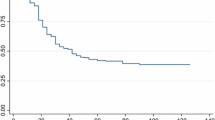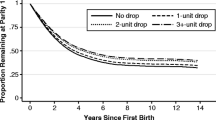Abstract
The existing literature has so far considered the role of the individual’s subjective well-being on fertility, neglecting the importance of the partner’s well-being. Using data from the British Household Panel Survey (BHPS) and event history models estimated separately by parity, we find that in a couple, women’s happiness matters more than that of the male partner in terms of having the first child. Specifically, we observe that couples in which either partner is happier than usual are more at risk of having the first child, but the effect is stronger with higher happiness of the woman. For the transition to the second child, we find that couples in which the woman declares to be happier or less happy than usual have a lower risk of childbirth. We, moreover, find support for a multiplicative effect of partners’ SWB on the decision to have a first child. Our results show that failing to acknowledge that the subjective well-being of both partners matters for the inherently joint decision making of childbearing can lead to an incomplete view of how subjective well-being affects fertility.
Similar content being viewed by others
References
Aassve, A., Mazzuco, S., & Mencarini, L. (2005). Childbearing and well-being: A comparative analysis of welfare regimes in Europe. Journal of European Social Policy, 15(3), 283–299.
Aassve, A., Goisis, A., & Sironi, M. (2012). Happiness and childbearing across Europe. Social Indicator Research, 108(1), 65–86.
Aassve, A., Sironi, M., & Bassi, V. (2013). Explaining attitudes towards demographic behaviour. European Sociological Review, 29(2), 316–333.
Aassve, A., Mencarini, L., & Sironi, M. (2015). Institutional change, happiness and fertility. European Sociological Review, 31(6), 749–765.
Allison, P. D. (1982). Discrete-time methods for the analysis of event histories. Sociological Methodology, 13(1), 61–98.
Balbo, N., & Arpino, B. (2016). The role of family orientations in shaping the effect of fertility on subjective well-being. Demography, 1–24. doi:10.1007/s13524-016-0480-z
Baranowska, A., & Matysiak, A. (2011). Does parenthood increase happiness? Evidence for Poland. Vienna Yearbook of Population Research, 9(2011), 307–325.
Bauer, G., & Kneip, T. (2013). Fertility from a couple perspective: A test of competing decision rules on proceptive behaviour. European Sociological Review, 29(3), 535–548.
Becker, G. S., Landes, E. M., & Michael, R. T. (1977). An economic analysis of marital instability. Journal of Political Economy, 85, 1141–1187.
Billari, F. C. (2009). The happiness commonality: Fertility decision in low-fertility settings. In UNECE (Ed.), How generations and gender shape demographic change (pp. 7–38). New York and Geneva: United Nations.
Clark, A. E., Diener, E., Georgellis, Y., & Lucas, R. E. (2008). Lags and leads in life satisfaction: A test of the baseline hypothesis. Economic Journal, 118(529), 222–243.
Clarkwest, A. (2007). Spousal dissimilarity, race, and marital dissolution. Journal of Marriage and Family, 69, 639–653.
Greenwood, J., Guner, N., Kocharkov, G., & Santos, C. (2014). Marry your like: Assortative mating and income inequality. American Economic Review, 104(5), 348–353.
Guven, C., Senik, C., & Stichnoth, H. (2012). You can not be happier than your wife: Happiness gaps and divorce. Journal of Economic Behavior and Organization, 82(1), 110–130.
Inglehart, R. (1971). The silent revolution in Europe: Intergenerational change in post-industrial societies. American Political Science Review, 65(4), 991–1017.
Jalovaara, M. (2003). The joint effects of marriage partners’ socioeconomic positions on the risk of divorce. Demography, 40(1), 67–81.
Keizer, R., & Schenk, N. (2012). Becoming a parent and relationship satisfaction: A longitudinal dyadic perspective. Journal of Marriage and Family, 74(4), 759–773.
Kohler, H., Behrman, J. R., & Skytthe, A. (2005). Partner + children = happiness? The effects of partnerships and fertility on well-being. Population and Development Review, 31(3), 407–445.
Le Moglie, M., Mencarini, L., & Rapallini, C. (2015). Is it just a matter of personality? On the role of life satisfaction in childbearing behavior. Journal of Economic Behavior & Organization, 117, 453–475.
Margolis, R., & Myrskylä, M. (2011). A global perspective on happiness and fertility. Population and Development Review, 37(1), 29–56.
Margolis, R., & Myrskylä, M. (2015). Parental well-being surrounding first birth as a determinant of further parity progression. Demography, 52(4), 1147–1166.
McDonald, P. (2002). Sustaining fertility through public policy: The range of options. Population-E, 57(3), 417–446.
Mencarini, L., & Tanturri, M. L. (2007). High fertility or childlessness: Micro-level determinants of reproductive behaviour in Italy. Population, 61(4), 389–415.
Milewski, N., & Kulu, H. (2014). Mixed marriages in Germany: A high risk of divorce for immigrant-native couples. European Journal of Population, 30(1), 89–113.
Myrskylä, M., & Margolis, R. (2014). Happiness: Before and after the kids. Demography, 51(5), 1843–1866.
Parr, N. (2010). Satisfaction with life as an antecedent of fertility. Demographic Research, 22(21), 635–662.
Perelli-Harris, B. (2006). The influence of informal work and subjective well-being on childbearing in post-Soviet Russia. Population and Development Review, 32(4), 729–753.
Pollmann-Shult, M. (2014). Parenthood and life satisfaction: Why don’t children make people happy? Journal of Marriage and Family, 76, 319–336.
Powdthavee, N. (2009). I can not smile without you: Spousal correlation in life satisfaction. Journal of Economic Psychology, 30, 675–689.
Testa, M. R., Cavalli, L., & Rosina, A. (2011). Couples’ childbearing behaviour in Italy: Which of the partners is leading it? Vienna Yearbook of Population Research, 9, 157–178.
Van de Kaa, D. J. (1987). Europe’s second demographic transition, population bulletin, 42 (1). Washington, DC: The Population Reference Bureau.
Acknowledgements
The authors gratefully acknowledge financial support from the European Research Council under the European ERC Grant Agreement no StG-313617 (SWELL-FER: Subjective Well-being and Fertility, P.I. Letizia Mencarini).




